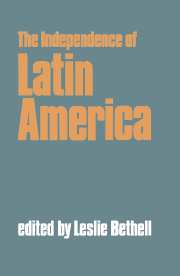Book contents
- Frontmatter
- Contents
- List of maps
- Preface
- 1 The origins of Spanish American Independence
- 2 The Independence of Mexico and Central America
- 3 The Independence of Spanish South America
- 4 The Independence of Brazil
- 5 International politics and Latin American Independence
- A note on the Church and the Independence of Latin America
- Bibliographical essays
- Index
3 - The Independence of Spanish South America
Published online by Cambridge University Press: 05 June 2012
- Frontmatter
- Contents
- List of maps
- Preface
- 1 The origins of Spanish American Independence
- 2 The Independence of Mexico and Central America
- 3 The Independence of Spanish South America
- 4 The Independence of Brazil
- 5 International politics and Latin American Independence
- A note on the Church and the Independence of Latin America
- Bibliographical essays
- Index
Summary
The crisis of the Spanish monarchy in 1808, which left the nation with no government of generally accepted legitimacy, could not help but have a profound impact on the American colonies from New Spain to the Río de la Plata. With hindsight it can be seen to have greatly accelerated those forces, already at work, which eventually produced the separation of the mainland colonies from Spain. At the time, however, outright independence appeared as one of only a number of possible responses, and it still had few proponents. Spanish Americans could accept the rule of Joseph Bonaparte. Alternatively, they could swear obedience either to the provisional authorities thrown up by the Spanish movement of national resistance against the French or else to Ferdinand VII's sister Carlota; the latter had earlier taken refuge in Rio de Janeiro with her husband, Dom João, prince regent of Portugal, and from there offered to rule temporarily on behalf of her brother. Or, again, they could establish native American juntas to rule in the name of the captive Ferdinand exactly as his Spanish provinces had done. In the short run this last alternative amounted to de facto autonomy within the framework of a common monarchy, while in the long run it was to prove a transitional stage to complete separation. Autonomy was nowhere sucessfully established before 1810, but that is not sufficient reason to take that year as the start of the independence movement; it is just that until 1810 the autonomists lost all their battles.
- Type
- Chapter
- Information
- The Independence of Latin America , pp. 93 - 154Publisher: Cambridge University PressPrint publication year: 1987
- 1
- Cited by



